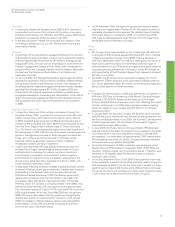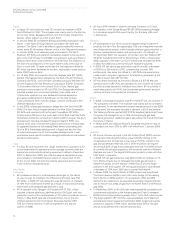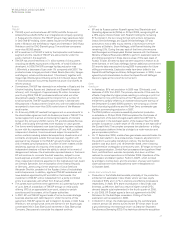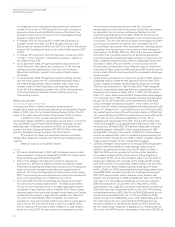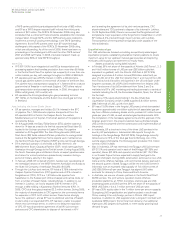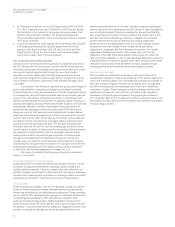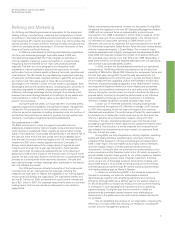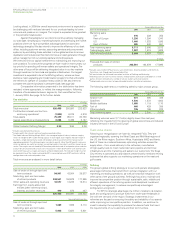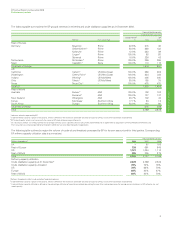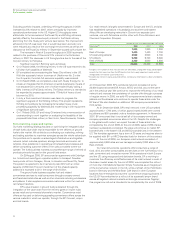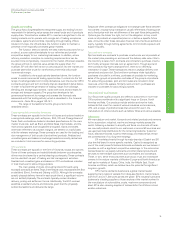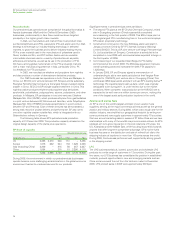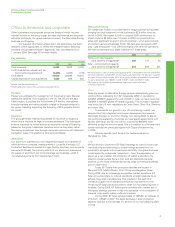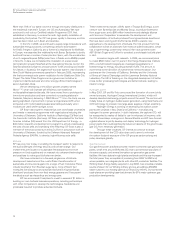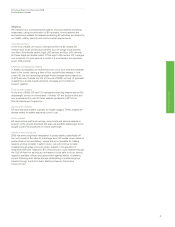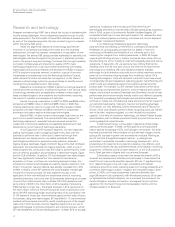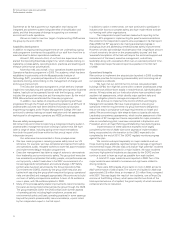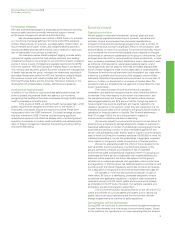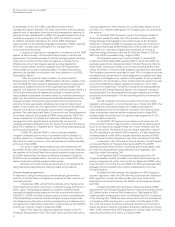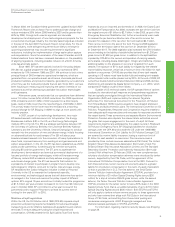BP 2008 Annual Report Download - page 36
Download and view the complete annual report
Please find page 36 of the 2008 BP annual report below. You can navigate through the pages in the report by either clicking on the pages listed below, or by using the keyword search tool below to find specific information within the annual report.
BP Annual Report and Accounts 2008
Performance review
Supply and trading
The group has a long-established integrated supply and trading function
responsible for delivering value across the overall crude and oil products
supply chain. This structure enables BP to maintain a single face to the oil
trading markets and to operate with a single set of trading compliance
processes, systems and controls. Operating through trading offices
located in Europe, the US and Asia, the function is able to maintain a
presence in the regionally connected global markets.
The function seeks to identify the best markets and prices for our
crude oil, source optimal feedstocks for our refineries and provide
competitive supply for our marketing businesses. In addition, where
refinery production is surplus to marketing requirements or can be
sourced more competitively, it is sold into the market. Wherever possible,
the group will look to optimize value across the supply chain. For
example, BP will often sell its own crude production into the market and
purchase alternative crude for its refineries where this will provide
incremental margin.
In addition to the supply activity described above, the function
seeks to create incremental trading opportunities. It enters into the full
range of exchange-traded commodity derivatives, over-the-counter (OTC)
contracts and spot and term contracts that are described in detail below.
In order to facilitate the generation of trading margin from arbitrage,
blending and storage opportunities, it also both owns and contracts for
storage and transport capacity. The group has developed a risk
governance framework to manage and oversee the financial risks
associated with this trading activity, which is described in the Financial
statements – Note 28 on pages 142-147.
The range of transactions that the group enters into is
described below:
Exchange-traded commodity derivatives
These contracts are typically in the form of futures and options traded on
a recognized exchange, such as Nymex, SGX, ICE and Chicago Board of
Trade. Such contracts are traded in standard specifications for the main
marker crude oils, such as Brent and West Texas Intermediate, and the
main product grades, such as gasoline and gasoil. Gains and losses,
otherwise referred to as variation margins, are settled on a daily basis
with the relevant exchange. These contracts are used for the trading and
risk management of both crude oil and refined products. Realized and
unrealized gains and losses on exchange-traded commodity derivatives
are included in total revenues for accounting purposes.
OTC contracts
These contracts are typically in the form of forwards, swaps and options.
Some of these contracts are traded bilaterally between counterparties;
others may be cleared by a central clearing counterparty. These contracts
can be used both as part of trading and risk management activities.
Realized and unrealized gains and losses on OTC contracts are included
in total revenues for accounting purposes.
The main grades of crude oil bought and sold forward using
standard contracts are West Texas Intermediate and a standard North Sea
crude blend (Brent, Forties and Osberg or BFO). Although the contracts
specify physical delivery terms for each crude blend, a significant volume
are not settled physically. The contracts typically contain standard
delivery, pricing and settlement terms. Additionally, the BFO contract
specifies a standard volume and tolerance given that the physically
settled transactions are delivered by cargo.
Swaps are often contractual obligations to exchange cash flows between
two parties: a typical swap transaction usually references a floating price
and a fixed price with the net difference of the cash flows being settled.
Options give the holder the right, but not the obligation, to buy or sell
crude or oil products at a specified price on or before a specific future
date. Amounts under these derivative financial instruments are settled at
expiry, typically through netting agreements, to limit credit exposure and
support liquidity.
Spot and term contracts
Spot contracts are contracts to purchase or sell crude and oil products at
the market price prevailing on and around the delivery date when title to
the inventory is taken. Term contracts are contracts to purchase or sell a
commodity at regular intervals over an agreed term. Though spot and
term contracts may have a standard form, there is no offsetting
mechanism in place. These transactions result in physical delivery with
operational and price risk. Spot and term contracts relate typically to
purchases of crude for a refinery, purchases of products for marketing,
sales of the group’s oil production and sales of the group’s oil products.
For accounting purposes, spot and term sales are included in total
revenues, when title passes. Similarly, spot and term purchases are
included in purchases for accounting purposes.
International businesses
Our IBs provide quality products and offers to customers in more than
100 countries worldwide with a significant focus on Europe, North
America and Asia. Our products include aviation and marine fuels,
lubricants that meet the needs of various industries and consumers,
LPG, and a range of petrochemicals that are sold for use in the
manufacture of other products such as fabrics, fibres and various plastics.
Lubricants
We manufacture and market lubricants and related products and services
to the automotive, industrial, marine and energy markets across the
world. Following a decision to simplify and focus our channels of trade,
we now sell products direct to our customers in around 50 countries and
use approved local distributors for the remaining locations. Customer
focus, distinctive brands, superior technology and relationships remain
the cornerstones of our long-term strategy.
BP markets primarily through its major brands of Castrol and BP,
plus the Aral brand in some specific markets. Castrol is recognized as
one of the most powerful lubricants brands worldwide and we believe it
provides us with a significant competitive advantage. In the automotive
lubricants sector, we supply lubricants and other related products and
services to intermediate customers such as retailers and workshops.
These, in turn, serve end-consumers such as car, truck and motorcycle
owners in the mature markets of Western Europe and North America as
well as the markets of Russia, China, India, the Middle East, South
America and Africa, which we believe have the potential for significant
long-term growth.
BP’s marine lubricants business is a global market leader,
supplying many types of vessels from deep-sea fleets to marine leisure-
craft from around 1,200 ports across the globe. BP’s industrial lubricants
business is a leading supplier to those sectors of the market involved in
the manufacture of automobiles, trucks, machinery components and
steel. BP is also a leading supplier of lubricants for the offshore oil and
aviation industries.
Performance review
35


